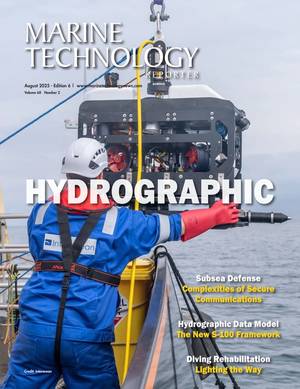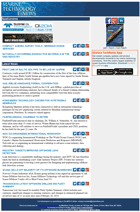
Fascinated by Shipwrecks Podcast: Episode 14
The SS Edmund Fitgerald was the largest ship on the Great Lakes when she was launched on June 7, 1958. She sank in a storm on November 10, 1975, on her way from Superior, Wisconsin, to Zug Island, Detroit, Michigan, with a load of taconite ore pellets. All 29 men were lost, and a haunting bell-ringing ceremony continues annually on November 10, at the Great Lakes Shipwreck Museum and the Mariner’s Church in Detroit, in tribute.In this episode, host Kathy A. Smith talks with Ric Mixter, wreck researcher, investigative journalist, and one of the foremost experts on the ship. He shares stories from

NV5 Advances Hydrography in the Great Lakes: Join the August 27 Live Webinar
NV5 has unveiled its latest precision hydrography innovations in the Great Lakes, enabling maritime stakeholders to “Own the Lakebed, Master the Mission." To showcase these breakthrough capabilities, NV5 will host a free, live webinar on Wednesday, August 27 at 1:00 PM CT/ 2:00 PM ET, offering a deep dive into how integrated hydrographic, terrestrial, and lidar data are transforming infrastructure planning and environmental monitoring in the region.From shoreline restoration to subsea cable routing and coastal resilience projects, complex Great Lakes environments demand highly accurate

Advancing Hydrography in the Great Lakes
In this live webinar, you’ll discover how our latest hydrographic survey innovations, developed and refined across multiple years of Great Lakes operations, can support your infrastructure, energy, and environmental initiatives.Hydrospatial experts from NV5, NOAA, and Exail will be presenting.We’ll highlight:- Survey efficiencies that cut timelines without compromising quality- Integration of hydrographic, terrestrial, and topobathymetric lidar data- Real-world applications that power better planning and decision-makingWednesday, August 27 at 1:00 PM CT / 2 PM ET.Register here.

US Announces $575 Million for Coastal Climate Resilience
The U.S. Department of Commerce announced its first-ever Climate Resilience Regional Challenge, which will provide $575 million in funding through President Biden’s Investing in America agenda to help coastal and Great Lakes communities, including tribal communities in those regions, become more resilient to extreme weather and other impacts of the climate crisis. The Challenge is the first and largest funding opportunity released under the $2.6 billion Inflation Reduction Act climate resilience framework that the Department unveiled in June. “Through this first-ever regional approach to

NOAA, Coast Guard to Collect Data from a Great Lakes Icebreaker
This week, NOAA's Office of Response and Restoration (OR&R) scientists worked with the U.S. Coast Guard during ice-breaking in Lake Superior Harbor in Duluth, Minnesota, aboard the Coast Guard Cutter Spar. This project is the first set of experiments funded by the newly developed Great Lakes Center of Expertise.Teams from both Coast Guard District 9 and NOAA deployed uncrewed aircraft system (UAS) with multispectral, thermal and LIDAR sensors to collect data while the Spar was breaking ice in the harbor. The team collaborated to develop data and mapping products that will advance

Ballast Water Management is Reducing the Flow of Invasive Species into the Great Lakes
by a host of environmental stressors from human activities. Among the most insidious and impactful of these is invasion by non-native species.Over the past two centuries, established populations of nearly 190 non-native species of invertebrates, fishes, plants and microbes have been discovered in the Great Lakes basin. They were introduced through several sources and pathways including canals, pet release, bait bucket dumping, aquaculture escapes and — most notably — ballast water discharge from transoceanic ships.Ballast tanks of ships may contain various life stages of invertebrates, larval

Canada Invests Over $3.9 million to Support the Great Lakes
Today, Terry Duguid, Parliamentary Secretary to the Minister of Environment and Climate Change, announced an investment of more than $3.9 million over three years in 39 new projects in Ontario through the Great Lakes Protection Initiative, part of the Government of Canada's Freshwater Action Plan.The announcement includes $98,000 over two years to the Niagara Peninsula Conservation Authority to conduct an assessment and provide options to manage contaminated sediment at Lyons Creek East in the Niagara River Area of Concern. The Mohawk Council of Akwesasne will receive $154,000 over two years to
New Under-ice Observing Capabilities Could Lead to New Discoveries in the Great Lakes
During the dog days of summer here in the Great Lakes, scientists at NOAA’s Great Lakes Environmental Research Laboratory (GLERL) are already thinking about the ice that will form on the lakes this winter.This year, NOAA GLERL and a team of federal, university, and industry partners are conducting test deployments of an autonomous underwater vehicle (AUV) in Lake Michigan, with the ultimate goal of using it under lake ice during winter to collect ecological and water quality data. Observations of winter ecology are difficult to obtain compared to observations in the ice-free season, when most

Research Buoys Deployed in Lake Michigan
and direction and wave height and direction.“We have never had any measurements in East Grand Traverse Bay previously, and having three strategically placed allows comparative understanding of the three separate but connected water bodies.” said Hans Van Sumeren, director of NMC’s Great Lakes Water Studies Institute.Purchased in 2021 with a $48,804 grant NMC received from the Great Lakes Observing System, the buoys were outfitted with webcams over the winter. The video feed of the lake surface is updated every 30 minutes.“These buoys and data will support a broader understanding

 August 2025
August 2025





